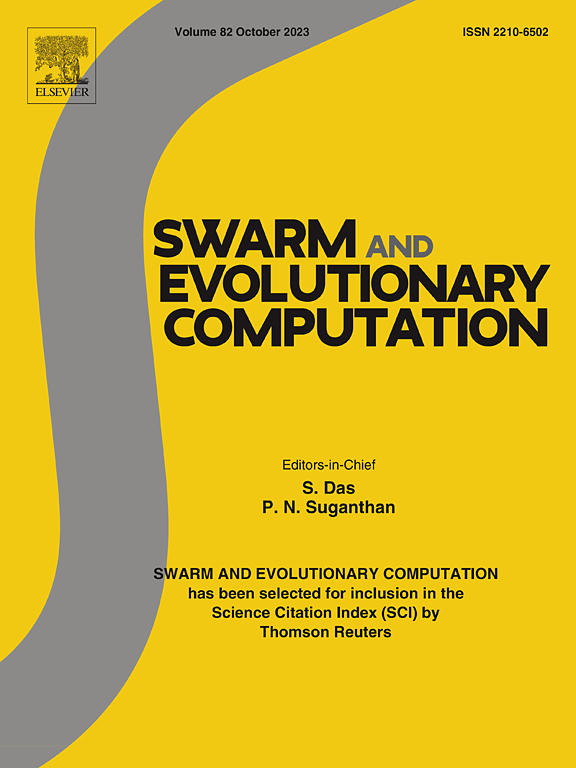An effective combination of mechanisms for particle swarm optimization-based ensemble strategy
IF 8.5
1区 计算机科学
Q1 COMPUTER SCIENCE, ARTIFICIAL INTELLIGENCE
引用次数: 0
Abstract
A high-quality ensemble strategy can effectively integrate several coefficients, mechanisms, and algorithms into a single framework. The adaptability, timing of intervention, and complementarity are the key factors to consider for the selected coefficients, mechanisms, and algorithms. In this study, two complementary variants based on Particle Swarm Optimization (PSO), namely Modified PSO (MPSO) and Social Learning PSO (SLPSO), were selected, forming IMPSO and ISLPSO after improvements. IMPSO excels at exploration, while ISLPSO excels at exploitation. The Improved Novel Ratio Adaptation Scheme (INRAS) is employed as a selection strategy and provides the ability to abandon less-optimal particles. The Modified Nonlinear Population Size Reduction (MNLPSR) enables the extension of generations, allowing for more sufficient evolution in later stages. Due to the use of MNLPSR, an improved inertia weight and adaptive acceleration coefficients are introduced to ensure compatibility with the proposed algorithm. Additionally, an improved dynamic differential mutation strategy is designed not only to be compatible with the proposed algorithm but also to enhance particle diversity. Both the Improved Sine Cosine Algorithm (ISCA) and Sequential Quadratic Programming (SQP), which focus on searching near the global best particles, are incorporated into the proposed ensemble strategy. This PSO-based variant is named the Effective Combination of Mechanisms for a PSO-based Ensemble Strategy (ECM-PSOES). Ablation experiments demonstrated the effectiveness of the individual coefficients and mechanisms. The novel PSO-based variant was evaluated on the CEC2017 benchmarks and compared with 14 state-of-the-art PSO-based variants and 11 non-PSO algorithms. Additionally, to evaluate the flexible and robust capability of the proposed algorithm, three real-world applications for long-term Transmission Network Expansion Planning (TNEP), Planetary Gear Train Design (PGTD), and Robot Gripper Design (RGD) were tested. The experimental results illustrate that the proposed algorithm displays superior performance compared to recently proposed PSO-based variants and most non-PSO algorithms. However, the proposed algorithm falls short of outperforming Differential Evolution (DE)-based algorithms and still requires time to match the performance of top-tier metaheuristics. The source code of ECM-PSOES is provided at https://github.com/microhard1999/CODES.
基于粒子群优化的集成策略的有效组合机制
一个高质量的集成策略可以有效地将多个系数、机制和算法集成到一个框架中。适应性、干预时机和互补性是选择系数、机制和算法时需要考虑的关键因素。本研究选取了基于粒子群优化(Particle Swarm Optimization, PSO)的两个互补变体,即Modified PSO (MPSO)和Social Learning PSO (SLPSO),改进后形成IMPSO和ISLPSO。IMPSO擅长探索,而ISLPSO擅长开发。采用改进的新比例适应方案(INRAS)作为一种选择策略,并提供放弃次优粒子的能力。修正的非线性种群大小缩减(MNLPSR)使世代扩展,允许在后期阶段更充分的进化。由于使用了MNLPSR,引入了改进的惯性权重和自适应加速度系数,以确保与所提算法的兼容性。此外,设计了一种改进的动态差分突变策略,不仅与所提出的算法兼容,而且提高了粒子的多样性。将改进的正弦余弦算法(ISCA)和序列二次规划(SQP)相结合,集中于全局最优粒子附近的搜索。这种基于pso的变体被命名为基于pso的集成策略机制的有效组合(ecm - psoe)。烧蚀实验证明了各系数和机理的有效性。新的基于pso的变体在CEC2017基准上进行了评估,并与14种最先进的基于pso的变体和11种非pso算法进行了比较。此外,为了评估该算法的灵活性和鲁棒性,对长期输电网络扩展规划(TNEP)、行星轮系设计(PGTD)和机器人夹持器设计(RGD)的三个实际应用进行了测试。实验结果表明,与最近提出的基于粒子群算法的变体和大多数非粒子群算法相比,该算法具有优越的性能。然而,该算法的性能低于基于差分进化(DE)的算法,并且仍然需要时间来匹配顶级元启发式算法的性能。ecm - psoe的源代码提供于https://github.com/microhard1999/CODES。
本文章由计算机程序翻译,如有差异,请以英文原文为准。
求助全文
约1分钟内获得全文
求助全文
来源期刊

Swarm and Evolutionary Computation
COMPUTER SCIENCE, ARTIFICIAL INTELLIGENCEC-COMPUTER SCIENCE, THEORY & METHODS
CiteScore
16.00
自引率
12.00%
发文量
169
期刊介绍:
Swarm and Evolutionary Computation is a pioneering peer-reviewed journal focused on the latest research and advancements in nature-inspired intelligent computation using swarm and evolutionary algorithms. It covers theoretical, experimental, and practical aspects of these paradigms and their hybrids, promoting interdisciplinary research. The journal prioritizes the publication of high-quality, original articles that push the boundaries of evolutionary computation and swarm intelligence. Additionally, it welcomes survey papers on current topics and novel applications. Topics of interest include but are not limited to: Genetic Algorithms, and Genetic Programming, Evolution Strategies, and Evolutionary Programming, Differential Evolution, Artificial Immune Systems, Particle Swarms, Ant Colony, Bacterial Foraging, Artificial Bees, Fireflies Algorithm, Harmony Search, Artificial Life, Digital Organisms, Estimation of Distribution Algorithms, Stochastic Diffusion Search, Quantum Computing, Nano Computing, Membrane Computing, Human-centric Computing, Hybridization of Algorithms, Memetic Computing, Autonomic Computing, Self-organizing systems, Combinatorial, Discrete, Binary, Constrained, Multi-objective, Multi-modal, Dynamic, and Large-scale Optimization.
 求助内容:
求助内容: 应助结果提醒方式:
应助结果提醒方式:


